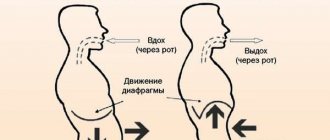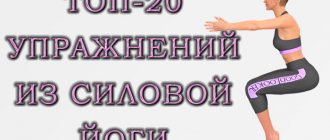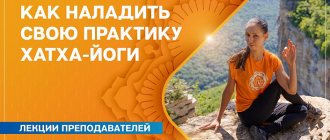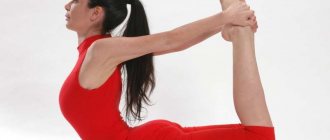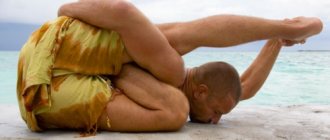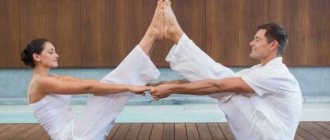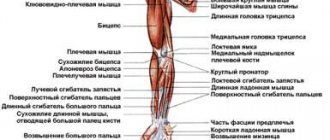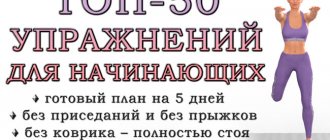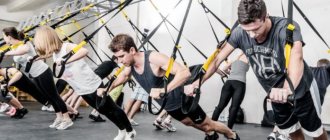There is a more neutral explanation that the definitions of "sthira" and "sukha" refer to peace and stability within us, to peace of mind. The development of such qualities can be achieved under static load with the help of strength and flexibility asanas of Hatha Yoga.
The third stage of Hatha Yoga
We have already mentioned the name Patanjali above. In the text “Yoga Sutras” he uses the word “ashtanga” to describe yoga, which literally means yoga of “eight steps” (ashta - eight, anga - part, step). We are talking about the following eight steps:
- pit (rules of interaction with the outside world),
- niyama (prescriptions for personal discipline),
- asana (achieving harmony in the activities of the body and mind through performing various poses),
- pranayama (control of vital energy through breath control),
- pratyahara (control of the senses, distracting them from various objects),
- dharana (concentration of the mind),
- dhyana (meditation),
- samadhi (the state of uniting one’s personal consciousness with absolute consciousness or, in other words, self-realization).
Questions, doubts and difficulties that beginners face
- Complex and incomprehensible names of asanas. Each asana has a Sanskrit name. There are many books on yoga that decipher and translate these names into Russian. Therefore, if you are confused or put off by Sanskrit names, you can take classes where yoga poses are spoken with translation. Good books with a list and translation of yoga asanas are “Yoga Dipika” (author B.K.S. Iyengar), “The ABC of Asanas” (authors are teachers of the oum.ru club).
- Are there any special benefits of asanas? The benefit of asanas is that they help overcome various health problems (for example, problems with the spine, joints, and the functioning of internal organs). There is also an opinion that the practice of asanas can influence a person’s energy, change his state of mind, relieve depression and negative emotions such as anger, resentment, jealousy, greed, envy.
- Yoga has a huge number of asanas. How to choose those that are right for me?
Depending on your life situation, various asanas will suit you. A few examples are listed below.
Vladimir Vasiliev
Asanas for men
Men usually have greater strength and endurance than women. Therefore, it is quite easy for them to do power asanas, simple balance asanas on the arms, and lying asanas, in which the abs and back are strengthened. The situation is more complicated with flexible poses, as well as twisting asanas. Therefore, when choosing a sequence of yoga exercises, it is advisable to pay attention to poses that develop flexibility and breathing. At the same time, maintaining a balance between strength and flexibility. Basic asanas for men are vrikshasana, virabhadrasana, utthita trikonasana, uttanasana, adho mukha svanasana, baddha konasana, salamba sarvangasana.
Chaturanga Dandasana (Four-Legged Staff Pose)
Yogajournal.com
Chaturanga is one of the most common asanas in vinyasa. It strengthens the arms and legs, tones the abdominal organs. When performing this pose, correct technique is very important, as haste can lead to lower back injuries.
Easy difficulty level. Many beginners do not have enough strength in their arms and abdominal muscles to achieve proper full alignment, so it is recommended that these individuals begin the practice by resting on their knees. It's important to focus on the muscles in your lower abdomen - this will help prevent your lower back from arching. The elbows should be tightly pressed to the ribs and clearly above the wrists.
Get into a plank position. The emphasis is on straightened arms, palms are clearly under the shoulders. Lower your legs to your knees, pull in your stomach and bend your elbows, as if doing a push-up with a close grip.
Medium level of difficulty. In a more complex version, you begin to stretch your body so that your chest goes forward and your tailbone goes back towards your heels. Your elbows should still be above your wrists. Make sure that the stomach is constantly pulled in (the navel tends to the spine), otherwise the pelvis will begin to rise.
High level of difficulty. This option is complicated by the emphasis on the toes (knees come off the floor). The body is stretched into a string, the stomach is pulled in, the lower back is flat, the gaze is directed to the floor. The pelvis should be level with the shoulders and chest, the toes should be in line with the heels. For the first time, you can rest your feet against the wall to take and remember the correct position.
Stay in this asana for 1-3 breathing cycles.
Asanas for women
Women find it easier to perform flexible asanas. However, over time, any body becomes enslaved, so girls and women of different ages often come to classes who find it difficult to perform basic yoga asanas. This applies to both strength and flexibility asanas. Basic yoga asanas for women are positions in which all systems of the body develop harmoniously, hormonal levels and the functions of all internal organs improve. Asanas are important for women's health. For example, baddha konasana, upavishta konasana, paschimottonasana, viparita karani mudra.
Banarasana I (high forward lunge pose)
Yogajournal.com
Banarasana opens the hip joints and lumbar region, straightens the chest and strengthens the legs.
Easy difficulty level. The main problem with this pose is maintaining balance. This is easy to fix - just look down, fixing your gaze on the point you have chosen. Make sure your feet are shoulder-width apart - this will make you more stable.
Medium level of difficulty. Once you've got the balance figured out, it's time to move on. Very often people lean forward, although this is not necessary. This leads to a feeling of tightness in the lower back and back leg. Bend your back knee enough to create a more stable position. As soon as you feel that you have taken the desired position, pull your pelvis forward a little and try to carefully straighten your back leg again. It's okay if it remains slightly bent.
High level of difficulty. Now try adding an arch element to the upper body. Straighten your arms above your head. You can connect them by clasping your palms together and straightening your index fingers pressed together. The neck is relaxed, the head is slightly thrown back. Try to lower your shoulders and open your chest as wide as possible, do not throw your pelvis forward.
It is recommended to stay in this pose for 8–10 breathing cycles.
Asanas for a healthy intestine
To improve intestinal motility, twisting and inverted asanas are usually recommended. One of the best twists for a healthy intestine is jathara parivartanasana. By the way, this pose is very helpful in losing weight and getting rid of belly fat. There are also asanas that will help get rid of constipation. These include utthita trikonasana, uttanasana, pavanmuktasana - this position removes gases from the intestines, ardha matsyendrasana, as well as any twists in the supine position.
Tibet. Observation deck next to Samye Monastery
True goals
The concept of “yoga” came to our world from Sanskrit: the word “eugene” contains the meaning of unification, connection, community, union.
This means that the main goal of yoga is to connect our inner “I” with the higher, to unite the bodily perception of ourselves with the spiritual.
Our perfect, wise higher “I” is called differently in the culture of other countries, but this does not affect the essence of its understanding.
For example, you may hear this divine energy referred to as the soul, God, Atman, the Absolute, the Inner Sage, the voice of the Universe, or the Supreme Mind.
The epithets characteristic of a given entity are different in each religion. One thing is important - with the help of yoga, a person begins to follow his true path from external to internal, begins to understand the highest laws of existence. Finds his purpose to benefit the world around him.
One of the goals of yoga is to learn to control your mind and use the acquired knowledge for the right purpose. When thoughts get out of control, a person becomes a selfish, restless person, filled with all kinds of fears. He cannot feel happy, calm and harmonious.
The main canons of yoga are written in ancient books that have survived to this day.
The most authoritative of them, in our opinion, are the following:
- Yoga Sutras of Patanjali with commentaries;
- Hatha Yoga Pradipika;
- Three-volume book of the Bihar School of Yoga;
- Hatha Yoga Dipika (B.K.S. Iyengar).
Asanas for the spine
If you have a healthy spine, there are no contraindications for practicing yoga. You can perform asanas standing, sitting, lying down, any balances, inverted poses. However, if there are any diseases of the spine, hernias, protrusions, scoliosis, then it is very important to study all the contraindications and, of course, contact a yoga therapy specialist who will work on your particular problem. It is important to remember that for a healthy spine you should not overuse flexibility exercises: do a lot of deep bends and other beautiful asanas that can aggravate your disease. The most important thing is the formation of a muscle corset, strengthening the back muscles. Classic asanas for the spine and strengthening the back - urdhva chaturanga dandasana, shalabhasana, utkatasana. Safe flexible poses that will also help relax all the back muscles and stretch the spine: majariasana, ardha bhujangasana, paschimotonasana.
Forward bends
Bends forward promote deep development of the hamstrings and all leg muscles. They relax the nervous system, promote spinal traction, calm and help improve sleep.
From the slopes, beginners can begin to master:
- Adho Mukha Svanasana;
- Paschimotanasana;
- Uttanasana;
- Parsvottanasana.
Asanas for joints
Dynamic sequences of asanas are very important for healthy joints. Various combinations of asanas and transitions from one pose to another warm up the body well and relieve stress on the joints. It is very important to combine all movements with breathing. The combination of movement and breathing makes yoga practice much more effective. Asanas that help work out the joints of the legs are agni stambhasana, gomukhasana, virasana, baddha konasana. It is also important to remember about the joints of your hands. In this case, for strengthening it is good to perform chaturanga dandasana, bhuja pidasana, bakasana, and for developing flexibility, swastikasana, eka bhuja padmasana, eka bhuja virasana are suitable.
Andrey Verba
Energy level
If we look deeper and assume that a person is not only a physical body, then here the practice of hatha yoga appears in a completely different light.
Asanas prepare energy channels for the perception of more powerful energy flows, the movement of which in direct practice depends on the speed of performing asanas, on the degree of effort applied, on breathing and many other factors.
This is why you cannot compare the practice of asanas with any other physical activity (fitness, for example). There are many nuances that a novice practitioner still has to comprehend.
The biggest mistakes beginners make in yoga
Haste and impatience
The result in any business comes only to those who know how to wait and endure. It’s the same in yoga. If you want to learn how to perform the most beautiful complex asanas (for example, hanumanasana - longitudinal splits or shirshasana - headstand), you need to be patient and regularly perform simple asanas for beginners. Then after some time the body will become stronger, gain flexibility, and you will be able to easily do any yoga poses.
Breath
Most beginners don't pay enough attention to breathing. In the pursuit of mastering more and more asanas, they forget about the quality and basic rules of yoga. All poses are performed in combination with proper breathing. To avoid this mistake, you need to spend some time at the beginning of the lesson setting up for practice and fine-tuning proper breathing (for example, full yogi breathing or Ujjayi breathing
Mind wandering
For beginning practitioners, performing asanas and thinking about oneself is a common thing. To overcome this limitation, there are some techniques that help stabilize attention and reduce distractions (for example, holding the tongue in the namo mudra position).
Whatever asanas you choose for your practice, it is important to remember the goals of your practice. Improving health and gaining additional energy are excellent motivation at the beginning of the journey. However, understanding that asanas are a special tool that helps make life rich, full, effective not only for yourself, but also for others, will open up much more altruistic goals and horizons for you.
Author of the article: Ekaterina Androsova
30-day at-home yoga program for beginners
The first month of classes can take place according to an already developed general program. It allows you to start practicing yoga at home, learn basic movements and improve your level of physical fitness.
The first day
- Start your session with stretching.
- Add three cycles of sun salutations.
- Rest for a few minutes in the dead man's pose.
Week 1
During the first week of classes, stretch every day and do Sun Salutations every other day. Combine standing and sitting poses during your workouts for a longer session at least three times a week. Remember to rest in Repose Pose at the end of each session.
Think about what time works best for you to study. A good opportunity to do yoga in the morning, you can start the day with stretching, find the best time.
Procedure for the first week:
- Day 1: stretching + 3 times Sun Salutation complex.
- Day 2: stretching + 3 times Sun Salutation complex + stretching in a sitting position.
- Day 3: Stretching.
- Day 4: stretching + 3 times Sun Salutation complex + stretching in a standing position.
- Day 5: Stretching.
- Day 6: stretching + 3 times Sun Salutation complex + stretching in a sitting position.
- Day 7: Stretching.
For the remainder of the month, you will perform short stretches daily and add variations to longer sequences of poses.
Week 2
- Day 1: Stretching.
- Day 2: stretching + 3 times Moon Salutation complex + sitting stretching + standing stretching.
- Day 3: Stretching.
- Day 4: stretching + 3 times Moon Salutation complex + standing stretches + balance poses.
- Day 5: Stretching.
- Day 6: stretching + 3 times Moon Salutation complex + standing stretching + yoga for the abs.
- Day 7: Stretching.
Week 3
- Day 1: Stretching.
- Day 2: stretching + 3 times Surya Namaskar + sitting stretching + standing stretching.
- Day 3: Stretching.
- Day 4: stretching + Surya Namaskar + standing stretching + balance poses + sitting stretching.
- Day 5: Stretching.
- Day 6: stretching + 3 times Surya Namaskar + standing stretching + yoga for the abs.
- Day 7: Stretching.
Week 4
- Day 1: Stretching.
- Day 2: stretching + 3 times Surya Namaskar + sitting stretching + standing stretching + arm yoga.
- Day 3: Stretching.
- Day 4: stretching + Surya Namaskar + standing stretching + balance poses + sitting stretching.
- Day 5: Stretching.
- Day 6: stretching + 3 times Surya Namaskar + standing stretching + abdominal yoga + sitting stretching.
- Day 7: Stretching.
The thirty-day workout program is a great way to start practicing yoga. It does not include overly complex elements. Regularly performing the same exercises allows you to master the technique and understand the basic principles of yoga. In the future, you can complicate the program and add new elements. And if in the first week there are no significant improvements in well-being, from the second week and subsequent days you can notice a significant improvement in tone and physical fitness. In addition, systematic exercise develops the habit of constantly performing asanas, and a person already develops the need to practice and practice when the process begins to bring true pleasure.
Important nuances
There are some important points that should be taken into account both for those who exercise at home and for people attending a yoga class at a fitness center. They concern what is not recommended and, conversely, what should be done.
It is forbidden:
- You should refrain from eating a heavy lunch or dinner. If classes are held in the morning, then from breakfast. A light snack should be no earlier than a few hours before the start of classes. This is much longer than for other physical activities.
- Drink fluids during class. To avoid feeling thirsty, you should drink plenty of water before exercise and then after.
- Exercise in shoes or socks. Asanas are done exclusively on bare feet.
It can be done better:
- If you purchase a subscription, then at the very first lesson you must tell the instructor about your level of physical fitness and experience in practicing yoga. Lessons are often held divided by level.
- Ask the instructor about things you don’t understand and don’t be shy about asking for help if something doesn’t work out.
- If something doesn’t work out in the first lesson, don’t be upset. Soon, asanas will be easy and simple, so you shouldn’t refuse to continue classes immediately after your first visit to the fitness center.
Parivritta Utkatasana II (Twisted Chair Pose)
Yogajournal.com
The twisted chair pose well opens the shoulder girdle, strengthens the hip muscles, develops a sense of balance and teaches how to perform twists.
Easy difficulty level. To start, simply try chair pose: stand up straight with your arms above your head and your knees slightly bent.
Medium level of difficulty. Now it's time to do some light twisting. To do this, fold your hands in a prayer gesture (Anjali mudra): press your palms together, spread your elbows to the sides. Then press as hard as possible on your palms and turn your body to the side.
High level of difficulty. For a full turn to the side, bend even lower and try to place your lower hand behind the outside of your knee, with your elbow pointing down at your foot. At the same time, try to extend your upper arm up and move it back a little. To increase the twist, push your leg with the elbow of your lower hand.
It is recommended to stay in this pose for 8–10 breathing cycles.
